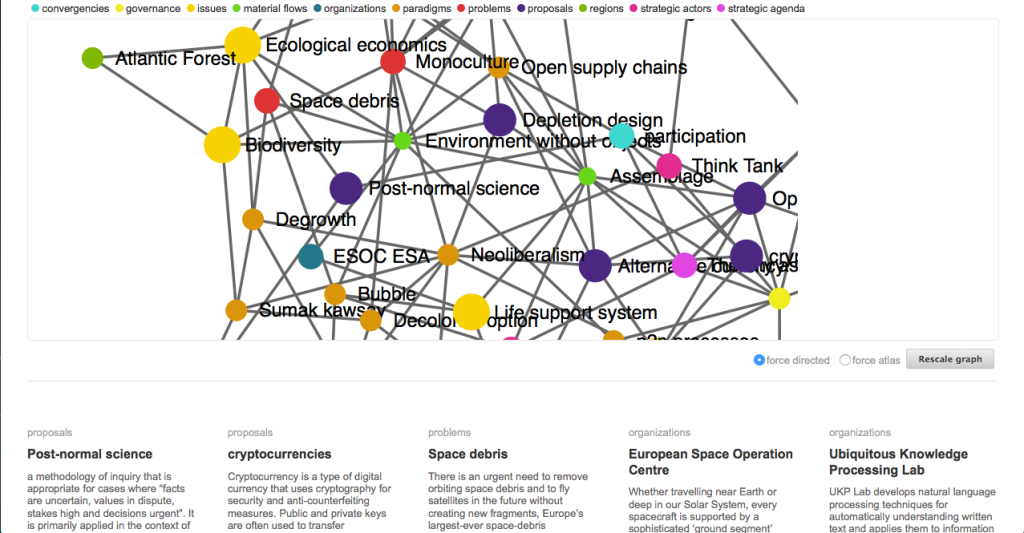Cartography for «Thinking together» at the Osthang Project.
How to open up several practices and make them interact to become spokespersons for their own fields?
Standards are reference buildings, a series of «principles useful for action» for the activists, participants based in their own practices. The collective writing of those practices can formalize the contributions of each participant without having a previous consensus.
A convergency without consensus.
These open standards mean they don’t wanto to agree, but to express the coexistence of hetergeneous protocols.
How to stage a process of collaboration, dialogue and debate between groups, practices and indivudulas?
How to raise issues from a collective conversation?
We will map the conversation at Thinking together to look at the issues raised during this seminar.
EXAMPLES OF PRACTICES
The «design and Build» movement
The «design and build» movement, if such a movement ever existed, It has been spread in the protocols of many architectural schools around Europe in the last decade. There is whole new generation of architects that are shaped by this apprenticeship. The handwork as part of a material education, many of the students are trained as carpenters before, the training to look at different source of waste as building materials, the same material reclamation in it self. The representational power that was used to be embodied by scale models for the modernist projects, is now taken by these building experiments 1 on 1.
These building practices have become a powerful way to teach architecture at schools, but they also address the constitution of a public sphere. Most of these practices are shown up at temporary events, displaying its bric a brac method as civic empowerment «take matters into your own hands».
Design as an open practice/Architecture as a «secret profession”
«Banham proposes to treat the architectural mode of thinking and communicating as a “black box” and claims that [architecture] “no longer seen as the mother of the arts, or the dominant mode of rational design, appears as the exercise of an arcane and privileged aesthetic code.” In direct conflict with this mode of operating, he points out that there is a tendency in the culture of architecture to make irrelevant comparisons. “The modern movement in spite of its inclusive approach undermines itself by using comparisons with certifiably non-architectural objects. They left the architectural body confused rather than reformed.” It’s the comparisons, analogies and metaphors to blame, according to Banham. A structure derived from the form of grain elevators, a high-rise generated in the spirit of an airplane wing, the building as poem. You know the routine – we’ve all waded through these waters.
Banham reveals that the culture of architecture is incomplete. And since architecture isn’t really sure what it is then the very role of architects is to defend this secrecy, to keep private the black box.»
Open Supply Chains
«Finally the tools to enable meaningful supply-chain transparency have come of age, and more people than ever before can use them. Until recently, visualizing global goods’ sourcing was the domain of contemporary artists and technoactivists. Tracing an object back to its origins could be a time-consuming and frustrating process that meant doing solitary research and creating original interfaces. But the increased accessibility of online mapping tools and wiki-style collaborations have changed the cartography of consumption.»
Extract from the «open source everything» manifesto:
«The Open-Source Everything Manifesto is a distillation of author, strategist, analyst, and reformer Robert David Steele life’s work: the transition from top-down secret command and control to a world of bottom-up, consensual, collective decision-making as a means to solve the major crises facing our world today. The book is intended to be a catalyst for citizen dialog and deliberation, and for inspiring the continued evolution of a nation in which all citizens realize our shared aspiration of direct democracy—informed participatory democracy. Open-Source Everything is a cultural and philosophical concept that is essential to creating a prosperous world at peace, a world that works for one hundred percent of humanity. The future of intelligence is not secret, not federal, and not expensive. It is about transparency, truth, and trust among our local to global collective. Only «open» is scalable.»


